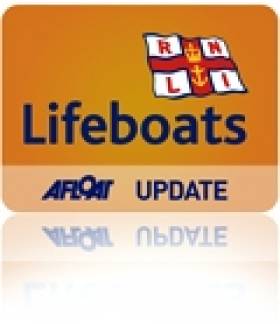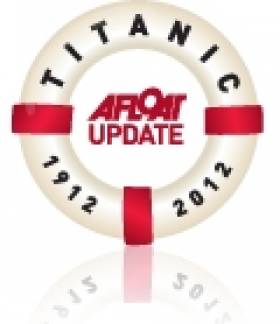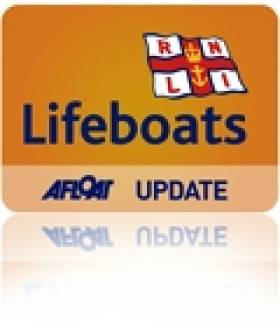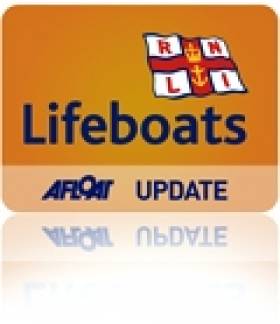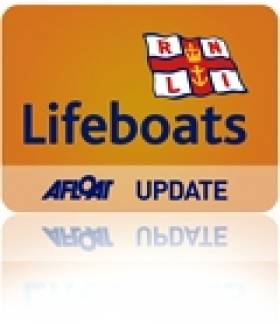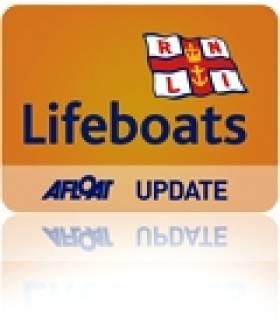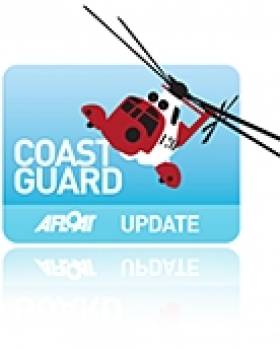Displaying items by tag: Lifeboats
#LIFEBOATS - The latest marine notice from the Department of Transport, Tourism and Sport (DTTAS) advises of construction work being carried out on Baltimore Lifeboat Station from today 5 March.
As previously reported on Afloat.ie, the works are part of a €2.6 million State-funded project to conduct essential remedial works at harbours across West Cork this year.
The works - which will be ongoing till mid-October pending weather conditions - will involve piling immediately adjacent to the foreshore on the north-east side of the building, and the deposition of rock to form an armoured breakwater jutting some 80m into Church Strand Bay.
No forseeable impact to mariners in the area is expected, but vessels are in any case requested to proceed slowly and with caution in the approach channel to Church Strand Bay and to give the works a wide berth to avoid wave-wash.
Further details for mariners are included in Marine Notice No 9 of 2012, a PDF of which is available to read and download HERE.
Fundraiser to Recreate Titanic's Last Meal
#TITANIC - Every seat has been snapped up for a special black-tie dinner in Galway next month that will recreate one of the last meals served on the Titanic.
Two menus recovered from the ship have provided the inspiration for the RNLI Galway lifeboat fundraiser, devised by self-described Titanic buff and culinary arts lecturer Noel Loughnane.
The extravagant 11-course meal, at €100 per head, includes such mouth-watering delights as filet mignon, foie gras, salmon with mousseline sauce and Calvados-glazed duckling - just as the ill-fated ship's first-class passengers would have enjoyed.
The Irish Times has more on the story HERE.
Lifeboats Receive 1,000 Calls for Help in 2011
#LIFEBOATS – RNLI Lifeboats in Ireland launched 980 times to a variety of call outs in 2011. 905 people were rescued over the course of the year by volunteer lifeboat crews who spent over 9,826 hours on service at sea.
Howth RNLI lifeboat station in Dublin was the busiest coastal Irish station, launching to 48 requests for help and, bringing 60 people to safety. They were followed by Crosshaven RNLI in Cork who launched 46 times and assisted 43 people. Enniskillen, one of Ireland’s two inland RNLI lifeboat stations which operates bases on both Upper and Lower Lough Erne, launched 52 times and brought 46 people to safety.
The busiest month for rescues was July with 155 launches followed by August with 124 calls for assistance. February 2011 was the busiest February for Irish launches in the RNLI’s history, as were May and October 2011.
Over a third of the RNLI’s call outs for last year were also carried out in darkness. The statistics show that launches to vessels suffering machinery failure still account for the largest number of call outs (187) followed by vessels reported to be in trouble (78), grounded (74) and capsizing (73).
Commenting on the 2011 statistics RNLI Deputy Divisional Inspector Gareth Morrison said: ‘Our lifeboat volunteers continue to show selfless dedication and commitment to saving lives. Some stations are extremely busy while others have less call outs but spend long hours at sea in awful conditions. There were some outstanding rescues last year including that to Rambler 100, in which Baltimore RNLI recovered 16 crew members off the upturned hull of the racing boat during the Fastnet race. Sadly there were also long searches for missing loved ones.
‘The work of the volunteer lifeboat crews could not be made possible without the generosity of the public who in difficult times continue to support Irish lifeboat crews. While these figures give an interesting insight into search and rescue by the RNLI on Irish waters they are by no means the full story. As well as working to save lives at sea the RNLI provides other programmes and services for the public including sea safety advice and clinics, education roadshows and visits to lifeboat stations.’
The 2011 figures are being released in the wake of the RNLI Lifejackets for Lifesavers campaign which will see every lifeboat station in Ireland take delivery of new specially designed lifejackets in September. The lifejackets have been commissioned by the RNLI for search and rescue work and have been given the seal of approval from lifeboat volunteers. The cost of providing the lifejackets for all 43 lifeboat stations in Ireland is estimated at €160,000.
Hangin' Around off Wicklow
#LIFEBOAT – Wicklow Lifeboat took part in a joint training exercise with an Air Corp helicopter in Wicklow bay on Saturday morning. The Air Corp AW139 helicopter crew landed on the Castle near the lifeboat Station at Wicklow harbour for a briefing prior to the exercise. During the exercise, three of the lifeboat crew were winched into the helicopter using various winch methods.
Actress Saoirse Ronan Calls to Wicklow Lifeboat Station
#SAOIRSE RONAN – Volunteer lifeboat crew with Wicklow RNLI received a surprise visitor during their navigation course this morning (Monday 23 January 2012). Well known actress Saoirse Ronan dropped in to say hello while filming nearby. The actress was filming scenes for director Neil Jordan's new film 'Byzantium' at Wicklow harbour.

The Hollywood actress makes her slipway debut
Tommy Dover, Wicklow RNLI volunteer said, " Saoirse kindly agreed to pose with some of the lifeboat crew from Wicklow RNLI and hear all about the work of the charity. We were delighted to welcome her and if she ever wants to sign up as lifeboat crew, she is more than welcome."
The RNLI is holding their SOS fundraising day this Friday with events happening all around the country. Funds raised are going towards purchasing new lifejackets for the volunteer lifeboat crews. The target is €160,000.
Wicklow RNLI lifeboat crew are no strangers to famous actors visiting the lifeboat station. Both Brendan Gleeson and Don Cheadle called into the lifeboat station while they were filming The Guard nearby.
Awards for RNLI Volunteers on Isle of Man
#RNLI - Peel Lifeboat Station is three times proud as a trio of its volunteers will receive awards for their services to the RNLI.
IsleOfMan.com reports that the badge winners were announced at the RNLI headquarters in Poole as part of its 2012 awards list.
Bronze badges will go to Francis Watterson and press officer and past chairman Malcolm Kelly, while Adrienne Teare was awarded a gold badge.
All three will be presented with their badges at a function later this year.
RNLI Peel is one of five lifeboat stations on the Isle of Man servicing much of the Irish Sea between northern England, Scotland and Ireland.
New Lifejackets for Irish Lifeboat Crews
#RNLI – The RNLI has launched a campaign which will see every lifeboat station in Ireland take delivery of new specially designed lifejackets this year. The lifejackets have been commissioned by the RNLI for search and rescue work and have been given the seal of approval from lifeboat volunteers.
Irish lifeboat crews at Dun Laoghaire, Wexford and Bangor were involved in the trials. Every aspect of a search and rescue operation was examined with the lifejackets designed to work in conjunction with the lifeboat volunteer to protect them and to aid their work.
The RNLI operates 43 lifeboat stations in Ireland ranging from the operation of inshore lifeboats up to all weather lifeboats capable of going one hundred miles out to sea. The cost of providing the lifejackets is estimated at €160,000 with costs at each station ranging from €2,500 up to €5,500. The charity is hoping that its national SOS fundraising day, to be held on Friday 27 January, will help raise some of the funds needed.
The RNLI continually looks to advance and improve its safety equipment. In the 1850s narrow strips of cork were sewn onto a canvas vest so the lifejacket could move with the body. Today crew lifejackets reflect decades of technological advancements. The new designs are more ergonomic and fitted to let the individual swim unhindered to aid casualties. They are lighter and more buoyant and will support the weight of a casualty being brought to safety by a crewmember in the water. They also have a luminous spray hood with visor, which can be pulled over the crewmembers head if they are in water to protect against sea spry while also making them highly visible. The lifejackets also come fitted with all the industry standard features such as water activated emergency lights, integral flare pockets, crotch straps and zipped pockets for casualty care cards, torches, gloves or knives.
Martyn Smith, RNLI Divisional Inspector for Ireland said, "Lifejackets are an essential piece of every lifeboat volunteer's kit. Whether they are operating from their lifeboat or recovering a casualty from the sea, their lifejacket is a lifesaver. This new design which is specially developed for search and rescue has some very important features that will aid them in their work. Replacing and updating our lifejackets is an ambitious project but one we feel is important as our crews deserve the best in equipment. I am grateful to the Irish lifeboat stations who trialled the lifejackets, they have helped deliver an outstanding piece of life saving equipment."
Emma Gibson, RNLI Area Fundraising Manager added, "The RNLI is a charity that relies on the generosity of the public and we are asking people to help us equip our lifeboat volunteers. Our national SOS fundraising day will take place on Friday 27 January and for this one we hope people will do something to help us raise funds for these new lifejackets.
The RNLI will also recycle the individual parts of the old lifejackets that have come to the end of their operational life, from steel and brass components to the fabric. If people wish to help or get involved with Lifejackets for Lifesavers they can call the RNLI on 01 895 1800 or email [email protected]
Coast Guard, RNLI Funding Escapes Cuts
#COASTGUARD – Funding for the Coast Guard and the RNLI will be protected at existing levels in 2012, Minister for Transport, Tourism & Sport Leo Varadkar confirmed today (Saturday). Speaking during a New Year's Eve visit to thank volunteers at the Coast Guard Station at Howth, Co. Dublin, Minister Varadkar also confirmed that the Coast Guard would remain within the Department of Transport, Tourism & Sport.
Minister Varadkar said: 'The Coast Guard performs an essential role all year round. I would like to extend my sincere thanks to every member of staff and volunteer for their efforts during 2011. I would also like to express my gratitude to the families of all the rescuers who make it possible for the volunteers to provide this 24 hour commitment throughout the year'.
Coast Guard Director Chris Reynolds confirmed that 2011 was one of the busiest years for the Coast Guard since its foundation. The Coast Guard responded to nearly 2,000 incidents this year, resulting in 163 lives being saved and over 3,300 persons assisted. The Coast Guard helicopters alone performed 551 missions during the year. Mr Reynolds said that staying within the Department of Transport, Tourism & Sport would facilitate the Coast Guard in the further development of maritime safety in Ireland, while also retaining its existing networks.
Minister Varadkar confirmed that the Coast Guard will receive €4.37 million for current purposes again this year, not including the helicopter service, and the RNLI annual grant of €150,000 will also be retained in 2012. The Minister has also allocated capital funding to allow the Coast Guard's aging fleet to be refreshed with new vessels over the next two years. New vessels have already been allocated to Coast Guard Stations at Achill, Bunbeg, Killala, Greencastle, Doolin and Killaloe.
The Minister confirmed that he has given the OPW the go-ahead to tender for a new Coast Guard Volunteer and Pollution Response Centre in Killybegs, Co. Donegal, and he re-confirmed his commitment to proceed with a similar station in Doolin within the life of the capital expenditure programme. 2012 will also see a significant improvement in the provision of helicopter rescue services with the arrival in Ireland of the new S92A Coast Guard helicopter in Shannon at the end of January.
Meanwhile, the Coast Guard's second national telecommunications network has been commissioned, providing a completely independent back-up service for the Coast Guard ship-to-shore communication network.
Mr Reynolds said: 'Ireland is a maritime nation which has rights over an area of seabed 10 times the size of Ireland. Ninety nine per cent of our trade goes by sea and it's no surprise that most of our population lives within 30km of the coast. In carrying out our goal to prevent, prepare and respond, the men and women of the Coast Guard staff, its volunteers, our helicopter crews and our partners in the Navy, Air Corps, RNLI, CRBI and mountain rescue, have continued to provide a world-class service. This has only been possible through the incredible service offered by locally-based volunteers nationwide and the commitment of this Government to maintain these essential front line services in difficult times'.
Dun Laoghaire Lifeboat to Mark Christmas Eve Tragedy
#LIFEBOAT – The crew of the RNLI lifeboat station at Dun Laoghaire will hold the traditional ceremony to remember the 15 volunteers that died on service in 1895 on Christmas Eve and for all lives lost at sea in the past year.
A short ceremony will be held at the lighthouse end of the East Pier at mid-day on Christmas Eve that will include music, an ecumenical blessing, a contemporary newspaper account of the 1895 tragedy and a piped lament. Both RNLI lifeboats stationed at Dun Laoghaire will launch and the crews will lay wreaths at sea.
The ceremony is an annual Christmas Eve tradition that remembers the lives of the 15 volunteer crew that died when their lifeboat capsized in gale force winds while attempting to rescue those on board the SS Palme that had run aground off Blackrock, Co. Dublin. All lives lost at sea in 2011 will also be included in the ceremony.
A special replica of the monument erected at the RNLI head-quarters in Poole, Dorset to remember all lifeboat crews lost while on duty, including the 15 Dun Laoghaire crew from 1895 will be presented to the station by Mr. Terence Johnson, Chairman of the Lifeboat management Group and will be on permanent display at the station.
"This event has become part of our local Christmas community tradition," said Stephen Wynne, Lifeboat Operations Manager at Dun Laoghaire. "Whether a descendant of the original lifeboat crew or simply looking for something alternative on Christmas Eve, everyone and their families are welcome to join us."
Marine Escapes Cuts in Latest Budget
#BUDGET - Coastguard and lifeboat services, mountain rescue and the Commissioners of Irish Lights will not face any further funding cuts in the latest Budget, according to the Minister for Transport.
The Irish Times reports that, following the reduction of his department's budget, Minister Leo Varakdar stated that substantial cuts have already occurred in the maritime safety sector.
Moreover, he announced an increase in the maritime budget from €70.5 million to €80.3 million, due to provisions for the new Irish Coast Guard helicopter contract.
Earlier this week, Minister for Agriculture, Food and the Marine, Simon Coveney, underlined the importance of the marine sector to Ireland's coastal communities.
As previously reported on Afloat.ie, Minister Coveney announced a round of expenditure estimates on Monday which include increased funding for investment in processing, aquaculture and fishery harbours.




























